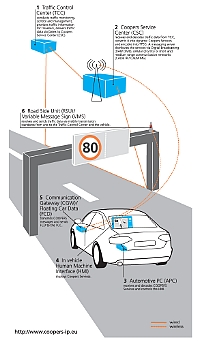Cooperative traffic management project reports success
Last updated Jul 3, 2010 — 101 views The EU’s COOPERS project recently completed extensive field tests of cooperative traffic management systems along heavily traveled motorways in Germany, Austria, Italy, France, and the Netherlands. The tests, conducted between January and June, demonstrated success from both the safety and user acceptance perspectives, according to the project.
The EU’s COOPERS project recently completed extensive field tests of cooperative traffic management systems along heavily traveled motorways in Germany, Austria, Italy, France, and the Netherlands. The tests, conducted between January and June, demonstrated success from both the safety and user acceptance perspectives, according to the project.
 COOPERS System Architecture (click image to enlarge) |
COOPERS is an acronym for “Cooperative Systems for Intelligent Road Safety.” The EU-funded project was chartered to develop and demonstrate a cooperative traffic management system through which vehicles connected via continuous wireless communication with road infrastructure on motorways would exchange data and information relevant to the specific road segment. The system’s goal is to increase overall road safety and enable cooperative traffic management for smoother and more efficient traffic flow.
The architecture of the COOPERS system (click the above image to enlarge) comprises the following six key subsystems:
- Traffic Control Center (TCC) — conducts traffic monitoring, control, and management; provides traffic information for travelers; delivers traffic data via Datex to the COOPERS Service Center (CSC)
- COOPERS Service Center (CSC) — receives and decodes traffic data from the Traffic Control Center, converts it into dynamic COOPERS Services, and encodes it into TPEG; a messaging server distributes the services via DAB/DVB digital broadcasting, 2G/3G cellular, or short/medium range communications networks (CALM IR / CALM MS)
- Automotive PC (APC) — receives and decodes COOPERS Services and controls the HMI
- In-vehicle Human Machine Interface (HMI) — displays COOPERS Services

COOPERS In-vehicle HMI - Communications Gateway (CGW) / Floating Car Data (FCD) transmits COOPERS messasges and sends FCD to the TCC
- Road Side Unit (RSU) / Variable Message Sign (VMS) receives and sends traffic data via mobile transmission standards from and to the Traffic Control Center and the vehicle
Based on this architecture, says the project, COOPERS “provides vehicles and drivers with real-time local situation based, safety-related traffic and infrastructure status information distributed via a dedicated infrastructure-to-vehicle (I2V) communications link.”
This approach “extends the concepts of in-vehicle autonomous systems and vehicle-to-vehicle (V2V) communication with tactical and strategic traffic information, which can only be provided by the infrastructure operator in real time,” the project’s documentation explains. “I2V, in this respect, will significantly improve traffic control and safety via effective and reliable transmission of data fully adapted to the local situation of the vehicle.”
The project claims the use of I2V and V2V communications and data exchange in cooperative systems for intelligent road safety can vastly extend the reliability and accuracy of the information provided to drivers and vehicles. This is especially valuable in regions of dense traffic, which are characterized by increased accidents and frequent traffic jams.
The real-time communication link between infrastructures and vehicles can also be used in reverse, for V2I communication — utilizing vehicles as “floating sensors” to verify infrastructure sensor data as a primary source for traffic control measures, the project adds.
Four demonstration sites
The COOPERS project provided the following summary of its recently-completed field tests:
- Demonstration site 1: the Brenner Corridor from Nuremberg to Verona — this site utilized CALM-IR (PDF file download) and DAB (as short/mid-range communication technology) wireless technologies for communications, executing the tests on three independent hotspots. Site 1’s field tests involved 115 test drives over 43 test days, from January through April.
- Demonstration site 2: the Rotterdam-Antwerp corridor — Two road operators were involved in this field demonstration: the Department Rijkswaterstaat, Dutch Ministry of Transportation and Water Management, and the Division of Traffic Centre, Department Mobility and Public Works, Flemish Government. The test drives were performed on the A16 between Dordrecht, Holland and Brecht, Belgium vice versa.
- Demonstration site 3: the Berlin city highway — One of the key challenge of the COOPERS project was to develop an overall architecture that would enable the integration and processing of multiple formats of traffic information by means of established communication technologies. At this site, the various available data sources from Verkehrs Management Zentrale, Berlin were utilized to generate COOPERS services and transmit them via digital broadcast (DAB) to the vehicle. Because the Berlin test section lies on an inner-city highway, a high number of messages were generated during each drive. Approximately 700 messages were generated automatically per day, resulting in an average of 25-50 messages per test drive. Overall, site 3 executed 43 successful test drives during March and April.
- Demonstration site 4: the French corridor from Chamonix to Valence, and the Paris area — this site utilized GPRS for its communications, enabling the COOPERS Service Center (CSC) to have a direct, bidirectional communication link with the Automotive PC (APC) unit. Local tests on site 4 reportedly included:
- Emergency call
- Influence zone
- Real Time Roadwork Information
- Alert in tunnel
A 60-page report on the results of the project’s recently-completed field tests, makes the point that the COOPERS system “is not just a laboratory prototype, but it has been tested under real conditions on heavily used sections of European motorways, on four different test sites.” As a result of the “planning, preparation, and execution of the field tests, the involved highway operators have gained important insights concerning the development, installation, and usage of co-operative systems,” the report adds.
“Conclusively, it can be said the road operators involved in the field tests consider the COOPERS project a success. The system has been demonstrated in daily operation, under real traffic conditions, and first results show that the expectations concerning safety and user acceptance have been fulfilled,” concludes the COOPERS field test report.
The complete, highly-detailed COOPERS system field test report is available for public download, here (PDF file).
The COOPERS project was launched in February, 2006 and has received nearly 17 million Euros in funding. For further details, visit the COOPERS project website.